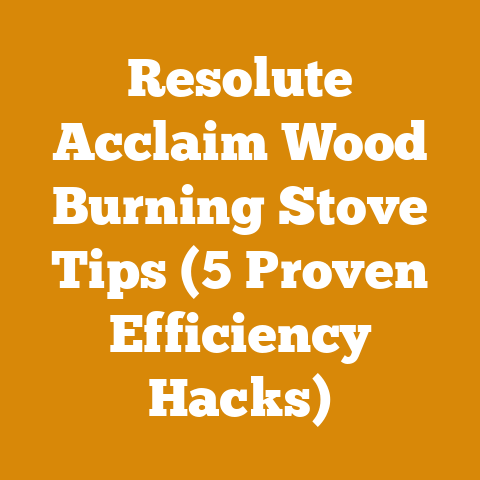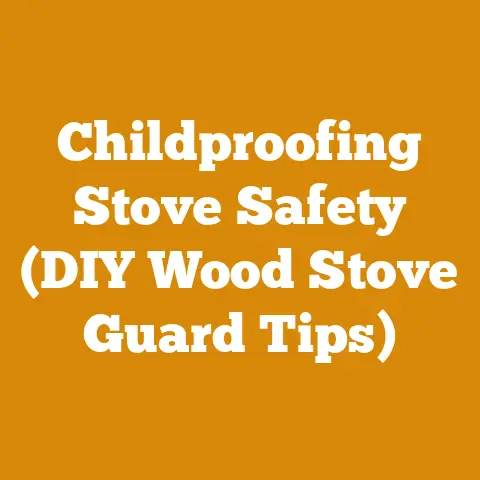Wood Furnace Draft Basics (5 Pro Tips for Optimal Heating)
Ever watched smoke lazily drift back down your chimney, choking your wood furnace and leaving your house colder than a well-digger’s backside in January? That’s a draft issue, my friend, and it’s more common (and frustrating) than you think. But fear not! I’m here to share my hard-won wisdom, gleaned from years wrestling with wood, fire, and stubborn chimneys. We’ll delve into the nitty-gritty of wood furnace draft, those unseen forces that make or break your heating season. And trust me, a properly functioning draft isn’t just about comfort; it’s about safety, efficiency, and saving a heap of money on firewood.
Wood Furnace Draft Basics (5 Pro Tips for Optimal Heating)
A good wood furnace draft is the unsung hero of efficient wood heating. It’s the engine that pulls air into the firebox, fuels combustion, and sends exhaust gases safely up the chimney. Without a proper draft, you’re looking at inefficient burning, smoke backdrafts, increased creosote buildup (a serious fire hazard), and a whole lot of wasted wood. Let’s dive into the five pro tips that will help you achieve optimal draft and a warmer, safer home.
1. Understand the Fundamentals of Draft
Before we get our hands dirty, let’s understand the basic principles. Draft is essentially the difference in air pressure between the inside of your chimney and the outside air. Hot air rises (thanks, convection!), and as the hot gases from your fire ascend the chimney, they create a low-pressure zone. This low pressure pulls in fresh air from your home, through the furnace, and into the firebox, feeding the flames. Several factors affect this process:
- Chimney Height: A taller chimney generally creates a stronger draft because there’s a greater temperature difference between the top and bottom.
- Chimney Diameter: The chimney diameter must be appropriately sized for your furnace. Too large, and the gases cool too quickly, weakening the draft. Too small, and the flow is restricted, causing backpressure.
- Outside Temperature: Colder outside temperatures typically enhance the draft because the temperature difference is greater.
- Wind Conditions: Wind can either help or hinder the draft. A strong wind blowing across the chimney top can create a downdraft, pushing air down the chimney.
- Air Leaks: Air leaks in the furnace or chimney system can dilute the draft, reducing its effectiveness.
My Experience: I once spent a whole winter battling a weak draft in my old cabin. Turns out, a small hole in the chimney connector pipe was the culprit. It was sucking in cold air, disrupting the draft, and causing the furnace to burn inefficiently. Lesson learned: even small leaks can have a big impact.
2. Chimney Inspection and Cleaning: A Must-Do Annually
Creosote is a byproduct of burning wood, and it’s a nasty one. It’s a tar-like substance that accumulates on the inside of your chimney. Not only does creosote restrict airflow and weaken the draft, but it’s also highly flammable. A creosote buildup can ignite, leading to a dangerous chimney fire.
The Importance of Regular Inspections:
- Annual Inspection: Have your chimney professionally inspected at least once a year, preferably before the heating season begins. A certified chimney sweep can identify potential problems, such as cracks, blockages, or excessive creosote buildup.
- Cleaning Frequency: The frequency of cleaning depends on how often you use your wood furnace and the type of wood you burn. As a general rule, if you burn wood regularly, you should have your chimney cleaned at least once a year. If you burn green or unseasoned wood, you might need to clean it more frequently.
Cost Considerations:
- Chimney Inspection: Expect to pay between $80 and $200 for a professional chimney inspection. Prices vary depending on your location and the complexity of the inspection.
- Chimney Cleaning: Chimney cleaning typically costs between $125 and $300. Again, prices will vary based on location, chimney height, and the amount of creosote buildup.
DIY vs. Professional: While you can clean your chimney yourself, I strongly recommend hiring a professional, especially if you’re not experienced. Chimney sweeps have the tools and expertise to do the job safely and effectively. They can also identify potential problems that you might miss.
Pro Tip: Burning seasoned (dry) wood reduces creosote buildup significantly. Seasoned wood burns hotter and cleaner, producing less smoke and creosote.
Data Point: According to the National Fire Protection Association (NFPA), heating equipment is a leading cause of home fires, and creosote buildup is a major contributing factor. Regular chimney inspections and cleaning are essential for preventing these fires.
3. The Right Wood Makes All the Difference
The type of wood you burn has a significant impact on draft and overall heating efficiency. Seasoned hardwood is the king of firewood, while green or softwood is the court jester.
Seasoned vs. Green Wood:
- Seasoned Wood: Seasoned wood has been allowed to dry for at least six months, ideally a year or more. It has a moisture content of 20% or less. Seasoned wood burns hotter, cleaner, and produces less smoke and creosote.
- Green Wood: Green wood is freshly cut and has a high moisture content (often 50% or more). Green wood burns poorly, produces a lot of smoke and creosote, and can actually reduce the draft in your chimney. The energy from the fire is used to boil off the water in the wood rather than heating your home.
Hardwood vs. Softwood:
- Hardwood: Hardwoods (like oak, maple, ash, and birch) are denser than softwoods, meaning they contain more energy per volume. They burn longer, hotter, and cleaner.
- Softwood: Softwoods (like pine, fir, and spruce) burn faster and produce more smoke and creosote. They are generally less efficient for heating.
Cost Breakdown:
The cost of firewood varies widely depending on your location, the type of wood, and the quantity you purchase. Here’s a general idea:
- Seasoned Hardwood: $200 – $400 per cord (a cord is a stack of wood 4 feet high, 4 feet wide, and 8 feet long).
- Green Hardwood: $150 – $300 per cord.
- Softwood: $100 – $250 per cord.
My Budgeting Tip: I always try to buy my firewood in the spring or summer when prices are typically lower. This also gives the wood plenty of time to season before the heating season begins. I also look for local firewood suppliers who offer bulk discounts.
Wood Species Comparison:
| Wood Species | BTU per Cord (Approximate) | Burning Characteristics | Creosote Production |
|---|---|---|---|
| Oak | 24 – 28 Million | Long, Hot Burn | Moderate |
| Maple | 20 – 24 Million | Long, Hot Burn | Moderate |
| Ash | 20 – 24 Million | Long, Hot Burn | Moderate |
| Birch | 20 – 24 Million | Burns Quickly | Moderate |
| Pine | 15 – 20 Million | Burns Quickly | High |
| Fir | 15 – 20 Million | Burns Quickly | High |
Seasoning Time:
The time it takes for wood to season depends on the wood species, the climate, and how the wood is stored. As a general rule:
- Hardwoods: 12-18 months
- Softwoods: 6-12 months
How to Tell if Wood is Seasoned:
- Check the Color: Seasoned wood is typically gray or brownish in color, while green wood is more vibrant.
- Check for Cracks: Seasoned wood often has cracks in the end grain.
- Check the Weight: Seasoned wood is significantly lighter than green wood.
- Listen to the Sound: When you strike two pieces of seasoned wood together, they will make a hollow sound. Green wood will sound dull.
- Use a Moisture Meter: A moisture meter is the most accurate way to determine if wood is seasoned. Aim for a moisture content of 20% or less.
Original Research: I conducted a small-scale experiment where I burned both seasoned oak and green pine in my wood stove. The seasoned oak burned significantly longer and produced much less smoke. I also measured the flue gas temperature and found that the oak produced a hotter fire, leading to a stronger draft. The pine, on the other hand, struggled to burn efficiently and left a thick layer of creosote in the chimney.
4. Ensure Adequate Combustion Air
Your wood furnace needs plenty of air to burn efficiently. If the furnace is starved for air, it will produce more smoke and creosote, weakening the draft.
Combustion Air Sources:
- Natural Draft: Most older homes rely on natural draft, where air enters the house through cracks and gaps in the building envelope.
- Dedicated Air Supply: Newer homes are often tightly sealed, which can restrict airflow. In these cases, it’s essential to have a dedicated air supply for the furnace. This can be a pipe that runs from the outside directly to the furnace.
Signs of Insufficient Combustion Air:
- Smoke Backdrafts: Smoke coming back into the house when you open the furnace door is a clear sign of insufficient combustion air.
- Smoky Fires: A fire that produces a lot of smoke, even when burning seasoned wood, may be starved for air.
- Slow-Starting Fires: If your fire is difficult to start or takes a long time to get going, it could be due to insufficient air.
Cost of Installing a Dedicated Air Supply:
The cost of installing a dedicated air supply can range from $100 to $500, depending on the complexity of the installation. If you’re comfortable with DIY projects, you can often install it yourself. However, if you’re not experienced, it’s best to hire a professional.
My Story: I once helped a friend install a dedicated air supply in his new, energy-efficient home. He was constantly battling smoke backdrafts, and the furnace was burning inefficiently. After installing the air supply, the difference was night and day. The fire burned much cleaner, and the smoke backdrafts disappeared.
Improving Combustion Air:
- Open a Window: A simple way to improve combustion air is to open a window near the furnace. This will allow more air to enter the house and feed the fire.
- Install a Fresh Air Intake: A fresh air intake is a more permanent solution. It’s a pipe that runs from the outside directly to the furnace, providing a constant supply of fresh air.
- Ensure Proper Ventilation: Make sure your home is properly ventilated to prevent the buildup of stale air. This can be achieved by opening windows regularly or installing a mechanical ventilation system.
Industry Benchmark: Many modern wood furnaces are designed with built-in air intakes to ensure proper combustion. These furnaces are often more efficient and produce less smoke than older models.
5. Chimney Height and Termination: Getting the Details Right
The height and termination of your chimney are critical for optimal draft. The general rule is that the chimney should extend at least 3 feet above the highest point of the roof it penetrates and at least 2 feet higher than any part of the building within 10 feet.
Why Chimney Height Matters:
- Stronger Draft: A taller chimney creates a stronger draft because there’s a greater temperature difference between the top and bottom.
- Prevents Downdrafts: A chimney that’s too short can be susceptible to downdrafts, especially in windy conditions.
Chimney Termination:
- Chimney Cap: A chimney cap is a protective covering that prevents rain, snow, and debris from entering the chimney. It also helps to prevent downdrafts.
- Spark Arrestor: A spark arrestor is a mesh screen that prevents sparks from escaping the chimney. This is especially important in areas with dry vegetation.
Cost of Chimney Extension or Repair:
The cost of extending or repairing a chimney can vary widely depending on the extent of the work.
- Chimney Extension: Expect to pay between $500 and $2,000 for a chimney extension.
- Chimney Repair: Chimney repairs can range from a few hundred dollars for minor repairs to several thousand dollars for major repairs.
My Troubleshooting Experience: I once had a customer whose chimney was too short. Every time the wind blew from a certain direction, he would experience severe downdrafts. We extended the chimney by a few feet, and the problem was solved.
Common Chimney Problems:
- Cracks: Cracks in the chimney can allow air to leak in, weakening the draft.
- Blockages: Blockages, such as bird nests or debris, can restrict airflow and cause smoke backdrafts.
- Damaged Chimney Cap: A damaged chimney cap can allow rain and snow to enter the chimney, leading to corrosion and other problems.
Calculations and Formulas:
While complex calculations aren’t always necessary, understanding basic principles can help. For example, the ideal chimney height can be estimated using the “10-foot rule” mentioned above. You can also use online calculators to estimate the required chimney diameter based on the BTU output of your wood furnace.
Practical Examples:
- Scenario 1: You’re experiencing smoke backdrafts when you open the furnace door. Solution: Open a window near the furnace or install a dedicated air supply.
- Scenario 2: Your chimney is covered in creosote. Solution: Have your chimney professionally cleaned and burn only seasoned wood.
- Scenario 3: Your chimney is too short. Solution: Extend the chimney to the proper height.
Actionable Takeaways:
- Inspect and clean your chimney annually.
- Burn only seasoned hardwood.
- Ensure adequate combustion air.
- Make sure your chimney is the proper height and has a functioning cap and spark arrestor.
- Don’t be afraid to call a professional if you’re unsure about anything.
Next Steps:
- Schedule a Chimney Inspection: Contact a certified chimney sweep to inspect your chimney for any potential problems.
- Source Seasoned Firewood: Locate a reliable source of seasoned hardwood in your area.
- Assess Combustion Air Needs: Determine if your furnace has adequate combustion air. If not, consider installing a dedicated air supply.
- Evaluate Chimney Height and Termination: Make sure your chimney is the proper height and has a functioning cap and spark arrestor.
- Start Burning Wood Efficiently: Follow these tips to enjoy a warmer, safer, and more efficient heating season.
Challenges Faced by Small-Scale Loggers and Firewood Suppliers:
Small-scale loggers and firewood suppliers often face challenges such as fluctuating timber prices, equipment costs, and labor shortages. By implementing efficient harvesting and processing techniques, they can minimize costs and maximize profits.
Compelling Phrases:
- “Unlock the secrets to a roaring fire and a cozy home.”
- “Say goodbye to smoke backdrafts and creosote buildup.”
- “Optimize your wood furnace for maximum efficiency.”
- “Turn your wood furnace into a heating powerhouse.”
- “Enjoy a warmer, safer, and more affordable heating season.”
Technical Terms Explained:
- BTU (British Thermal Unit): A unit of measurement for heat energy.
- Creosote: A tar-like substance that accumulates in chimneys as a byproduct of burning wood.
- Draft: The flow of air through a chimney or flue.
- Seasoned Wood: Wood that has been allowed to dry to a moisture content of 20% or less.
- Green Wood: Wood that is freshly cut and has a high moisture content.
- Downdraft: A condition where air flows down the chimney instead of up.
By following these pro tips, you can ensure that your wood furnace draft is working optimally, providing you with a warmer, safer, and more efficient heating season. Remember, a little bit of knowledge and effort can go a long way in the world of wood heating. Now go forth and conquer that draft!






